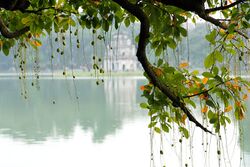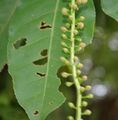Biology:Barringtonia acutangula
| Barringtonia acutangula | |
|---|---|

| |
| A Barringtonia acutangula tree at Hoan Kiem Lake | |
| Scientific classification | |
| Kingdom: | Plantae |
| Clade: | Tracheophytes |
| Clade: | Angiosperms |
| Clade: | Eudicots |
| Clade: | Asterids |
| Order: | Ericales |
| Family: | Lecythidaceae |
| Genus: | Barringtonia |
| Species: | B. acutangula
|
| Binomial name | |
| Barringtonia acutangula (L.) Gaertn.
| |
| Synonyms[2] | |
| |
Barringtonia acutangula is a species of Barringtonia native to coastal wetlands in southern Asia and northern Australasia, from Afghanistan east to the Philippines , Queensland and the Northern Territory. Common names include freshwater mangrove, itchytree and mango-pine.[3]
Description
This plant is a big tree that grows to about 8–15 m high. Its leaves are thick, smooth and oval in shape, about 8–12 cm long and 4–5 cm wide, with reddish petioles about 0.5–1.0 cm long. The plant has drooping raceme of up to 50 cm long, with numerous large, white flowers. Its fruit is oval-shaped and about 3 cm long, with 1 seed inside.[4]
Uses
Food
The young leaves of this plant are consumed as food, such as in Vietnam where they are eaten fresh with other vegetables, meat and shrimp.[4]
Medicinal
Research on this plant has reported a number of medicinal uses, including antitumor (seed extract),[5] antibiotic,[6] inhibition of growth of Helicobacter pylori,[7] antinociceptive activity[8] and antifungal activity.[9][10]
The 1889 book 'The Useful Native Plants of Australia’ records that "In India an extract or juice is obtained from the leaves of this tree which, when mixed with oil, is used in native [sic.] practice for eruptions of the skin. The kernels powdered and prepared with sago and butter, are used in diarrhoea; mixed with milk they produce vomiting (Treasury of Botany). The root is bitter, and is said to be similar to Cinchona, but also cooling and aperient. (Drury)."[11]
Chemistry
Its bark contains potent painkillers, structurally unrelated to known opioid painkillers [1]
Also 3,3'-dimethoxy ellagic acid, dihydromyricetin, gallic acid, bartogenic acid and stigmasterol,[12] triterpenoids, olean-18-en-3beta-O-E-coumaroyl ester and olean-18-en-3beta-O-Z-coumaroyl ester[13] 12, 20(29)-lupadien-3-o[14]
Oleanane-type isomeric triterpenoids:- racemosol A (1) [22alpha-acetoxy-3beta,15alpha,16alpha,21beta-tetrahydroxy-28-(2-methylbutyryl)olean-12-ene] and isoracemosol A (2) [21beta-acetoxy-3beta,15alpha,16alpha,28-tetrahydroxy-22alpha-(2-methylbutyryl)olean-12-ene].[15]
Saponins,:[16][17] barringtoside A, 3-O-beta-D-xylopyranosyl(1-->3)-[beta-D-galactopyranosyl(1-->2)]-beta-D- glucuronopyranosyl barringtogenol C; barringtoside B, 3-O-beta-D-xylopyranosyl(1-->3)-]beta-D-galactopyranosyl(1-->2)]-beta-D- glucuronopyranosyl-21-O-tigloyl-28-O-isobutyryl barringtogenol C; barringtoside C, 3-O-alpha-L-arabinopyranosyl(1-->3)-[beta-D-galactopyranosyl(1-->2 )]-beta-D - glucuronopyranosyl barringtogenol C.
Photos
References
- ↑ Barstow, M. (2019). "Barringtonia acutangula". IUCN Red List of Threatened Species 2019: e.T61533369A61533372. doi:10.2305/IUCN.UK.2019-1.RLTS.T61533369A61533372.en. https://www.iucnredlist.org/species/61533369/61533372. Retrieved 19 November 2021.
- ↑ "Barringtonia acutangula". World Checklist of Selected Plant Families (WCSP). Royal Botanic Gardens, Kew. http://wcsp.science.kew.org/namedetail.do?name_id=313389.
- ↑ {{citation | mode = cs1 | title = Barringtonia acutangula | work = Germplasm Resources Information Network (GRIN) | url = | publisher = [[Organization:Agricultural Research ServAgricultural Research Service (ARS), United States Department of Agriculture (USDA) | access-date = 29 December 2017 }}
- ↑ 4.0 4.1 Tanaka, Yoshitaka; Van Ke, Nguyen (2007). Edible Wild Plants of Vietnam: The Bountiful Garden. Thailand: Orchid Press. p. 88. ISBN 978-9745240896.
- ↑ Samanta S.K.; Bhattacharya K.; Mandal C.; Pal B.C. (2010). "Identification and quantification of the active component quercetin 3-O-rutinoside from Barringtonia racemosa, targets mitochondrial apoptotic pathway in acute lymphoblastic leukemia". Journal of Asian Natural Products Research 12 (8): 639–48. doi:10.1080/10286020.2010.489040. PMID 20706898.
- ↑ Rahman MM; Polfreman D.; MacGeachan J.; Gray AI (2005). "Antimicrobial activities of Barringtonia acutangula". Phytotherapy Research 19 (6): 543–5. doi:10.1002/ptr.1341. PMID 16114086.
- ↑ Bhamarapravati S; Pendland SL; Mahady GB (2003). "Extracts of spice and food plants from Thai traditional medicine inhibit the growth of the human carcinogen Helicobacter pylori". In Vivo. 17 (6): 541–4. PMID 14758718.
- ↑ Deraniyagala SA; Ratnasooriya WD; Goonasekara CL (2003). "Antinociceptive effect and toxicological study of the aqueous bark extract of Barringtonia racemosa on rats". Journal of Ethnopharmacology 86 (1): 21–6. doi:10.1016/s0378-8741(03)00015-1. PMID 12686437.
- ↑ Vijaya Bharathi R.; Jerad Suresh A.; Thirumal M.; Sriram L.; Geetha Lakshmi S.; Kumudhaveni B. (2010). "Antibacterial and antifungal screening on various leaf extracts of Barringtonia acutangula". International Journal of Research in Pharmaceutical Sciences 1 (4): 407–410.
- ↑ Sahoo S.; Panda P.K.; Behera P.S.; Mishra S.R.; Ellaiah P. (2008). "Antifungal activity of Barringtonia acutangula against selected human pathogenic fungi". Indian Drugs 45 (1): 26–30.
- ↑ J. H. Maiden (1889). The useful native plants of Australia : Including Tasmania. Turner and Henderson, Sydney. https://primo-slnsw.hosted.exlibrisgroup.com/primo-explore/fulldisplay?docid=SLNSW_ALMA21105097830002626&context=L&vid=SLNSW&search_scope=EEA&tab=default_tab&lang=en_US.
- ↑ Chemical constituents of mangrove plant Barringtonia racemosa]. [Chinese] Sun HY. Long LJ. Wu J. Zhong Yao Cai. 29(7):671-2, 2006 Jul.
- ↑ "Two new 18-en-oleane derivatives from marine mangrove plant, Barringtonia racemosa". Pharmazie 61 (4): 365–6. 2006. PMID 16649558.
- ↑ "Antimicrobial activities of Barringtonia acutangula". Phytotherapy Research 19 (6): 543–5. 2005. doi:10.1002/ptr.1341. PMID 16114086.
- ↑ "Oleanane-type isomeric triterpenoids from Barringtonia racemosa". Journal of Natural Products 72 (4): 791–5. 2009. doi:10.1021/np8007396. PMID 19388709. https://figshare.com/articles/journal_contribution/2861632.
- ↑ Pal BC. Chaudhuri T. Yoshikawa K. Arihara S 1994 Saponins from Barringtonia acutangula. Phytochemistry 35(5):1315-8,
- ↑ Mills C.; Carroll A.R.; Quinn R.J. (2005). "Acutangulosides A-F, monodesmosidic saponins from the bark of Barringtonia acutangula". Journal of Natural Products 68 (3): 311–318. doi:10.1021/np049741u. PMID 15787427.
External links
- "Barringtonia acutangula (L.) Gaertn.". Atlas of Living Australia. https://bie.ala.org.au/species/http://id.biodiversity.org.au/node/apni/2899118.
Wikidata ☰ Q2248481 entry
 |












